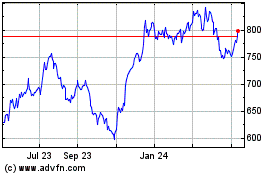BlackRock Media Statement Regarding Recent Credit Rating Actions Related to U.S. Government Debt
August 07 2011 - 6:01PM
Business Wire
The downgrade of U.S. sovereign credit by S&P on Friday
reflects facts that have been well known to the market for some
time. So, it does not imply a fundamental increase in risk, and we
don’t believe that investors should change their behavior based
solely on the downgrade. However, in combination with continued
economic weakness and regulatory uncertainty, this may provide a
signal to some investors to reassess their risk appetite.
BlackRock has been preparing for the possibility of downgrade
over the past month, and, the firm has no need to execute any
forced selling of securities in response to the S&P action.
In anticipation of a potential ratings downgrade, BlackRock had
a task force from across the company review all aspects of our
business that transact in U.S. Treasuries and related securities
and developed a detailed game plan to follow in the event of a
downgrade, which we have executed throughout the weekend. We also
are prepared for continued downgrades into next week of the many
other issuers and issues that derive their rating from the U.S.
government rating – including the GSEs and some corporates.
While we have worked closely with our clients to clarify their
investment guidelines, and to inform them of possible market
reactions resulting from a downgrade of U.S. sovereign credit, this
is but one of myriad of concerns investors face in markets
today.
Much of the developed world faces high levels of indebtedness,
slowing economic growth, and significant potential for policy
missteps. Taken together, these elements have dramatically
increased market volatility and reduced liquidity.
The weakness in labor markets, when combined with only modest
levels of growth, argues for a high likelihood that the Federal
Reserve will maintain its Fed Funds policy range at historically
accommodative levels for at least another year and perhaps through
2012.
Moreover, we believe the Fed will want to continue supporting
the recovery in any manner it can in light of an extraordinarily
anemic real growth rate of 0.4% for the first quarter of 2011,
revised downward from 1.9%, and a below consensus estimate of 1.3%
for the second quarter,.
Alongside these fundamental concerns over the status of the
economic recovery in the U.S., the expanding European sovereign
debt crisis continues to heighten the risk of a significant slowing
in European growth.
The European crisis highlights the impact that slow moving and
poorly conceived policy decisions can have on financial markets. At
its core, liquidity has been provided to attempt to address a
solvency problem, and sovereign credit markets have remained
unconvinced of the ultimate efficacy of each successive "solution"
to the widening of peripheral country debt spreads.
Nonetheless, we think it is vital to underscore the fact that
the U.S. Treasury sector (and to a slightly lesser extent
Agency-backed MBS) remains the largest and most liquid fixed income
market in the world with the greatest degree of price transparency
and few genuine alternatives.
While the events that led to the S&P downgrade are certainly
of concern, we think the vast majority of investors will continue
to utilize the Treasury yield curve as an effective credit
risk-free benchmark against which credit spread issues can be
judged.
Treasuries will also continue to see a strong bid from
institutional investors of all kinds (including banks) and will
continue to serve their traditional role as a hedge to risk assets.
While a time may come when the credit risk-free status of Treasury
bonds is diminished by continued policy missteps, we do not believe
that the S&P downgrade signals that this moment has come
now.
Addressing the fiscal challenges that confront the United States
is a long-term undertaking. Those challenges cannot be overcome
through short-term fixes but will require efforts extending over
many years. The U.S. economy has historically been the world’s most
resilient, but its future depends on policymakers coming together
to make the hard decisions needed to arrest the growth of the U.S.
public deficit. There is time to address these challenges, but if
policymakers fail to do so, this weekend’s credit downgrade will be
a sign of continued fiscal deterioration.
About BlackRock
BlackRock is a leader in investment management, risk management
and advisory services for institutional and retail clients
worldwide. At June 30, 2011, BlackRock’s AUM was $3.659 trillion.
BlackRock offers products that span the risk spectrum to meet
clients’ needs, including active, enhanced and index strategies
across markets and asset classes. Products are offered in a variety
of structures including separate accounts, mutual funds, iShares®
(exchange-traded funds), and other pooled investment vehicles.
BlackRock also offers risk management, advisory and enterprise
investment system services to a broad base of institutional
investors through BlackRock Solutions®. Headquartered in New York
City, as of June 30, 2011, the firm has approximately 9,700
employees in 26 countries and a major presence in key global
markets, including North and South America, Europe, Asia, Australia
and the Middle East and Africa. For additional information, please
visit the Company's website at www.blackrock.com.
BlackRock (NYSE:BLK)
Historical Stock Chart
From May 2024 to Jun 2024

BlackRock (NYSE:BLK)
Historical Stock Chart
From Jun 2023 to Jun 2024
